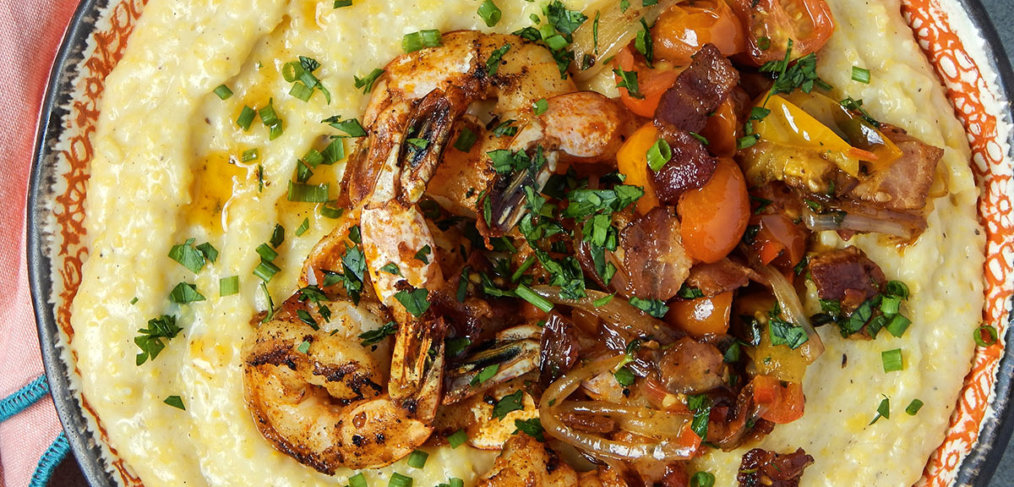
Low Country Shrimp & Grits
Makes 4 Servings
The Shrimp and Grits dish we know of today is actually quite a recent trend in restaurants and magazines. It was popularized by a chef, Bill Neal in 1982 in a restaurant called, Crook’s Corner. He glamorized the once humble dish of the Low Country. The dish had been eaten long before that. It was a one-pot meal for working men, both fishermen and men working in the fields. Shrimp was also easy to catch in the creeks with hands, to supplement rations given by Plantation owners. Grits were native to the area; the Native American Muskogee Tribe taught the settlers their hand-ground technique that creates what we know as grits.
Shrimp and Grits is attributed to the Mozambican slaves that were brought into the Low Country; so here is a brief history of Mozambique and the slave trade and agriculture.
The Bantu people, who were agricultural farmers settled in the region in 300AD introducing Agriculture to the area. They sought out land that was well-equipped for farming. They grew rice and other grains including Maize. The maize was used to create a dish known today as Maize Porridge, which is extremely similar to creamy polenta or creamy grits we Southerners love. Maize Porridge was also known to have been served alongside shellfish.
Arab nations began trading goods with the people of Mozambique as well as capturing the native people to be used as slaves as early as the 400AD. The trade with Arab nations also brought spices and other grains into the region.
Vasco de Gama, a Portuguese trader landed on Mozambique Island as a “pit-stop” in 1498 on his way to India to trade for spices and other goods. This introduced the Europeans to the region and they began to settle and colonize. The Portuguese gained control and occupied a large portion of the Coast of Mozambique to the Northern coast of modern-day Zimbabwe by 1632; and established mining camps in the highlands, despite the fact that settlers weren’t too keen on living in the mining areas.
By 1693, the Portuguese were forced out of the highlands due to a revolt led by a local tribe, however, this led to the Portuguese establishing themselves further down the coast throughout the 1700s encouraging Europeans and American Colonists to trade for ivory and whale hunt. In the 1800s there was an influx of slave trading from Mozambique due to droughts and a hurricane that devastated the land for growing crops and raising cattle. In the 1800s over 100,000 people were sent to the Americas. Most were transported to South America to work in the sugar cane industry, however, quite a few ended up in Charleston and the Low Country.
A side note: The descendants of slaves originating from Mozambique, Ghana, Sierra Leone, Ivory Coast, Madagascar, Bight of Benin and Angola are still present today in the Low Country, where they practice their ancient traditions. They are called the Gullah people or Gullah Geechee people. Before the Emancipation Proclamation, these people were freed from slavery (some of the first in the South) and resided in the Low Country, mostly in the Sea Islands. Pennsylvania Unitarian missionaries established schools for them to learn and grow as a community. Also, these people were South Carolina’s first volunteers for the Union Army.
4 cups unsalted chicken broth
1 3/4 teaspoon sea salt, divided
1 cup grits
6 slices thick-cut bacon, no nitrites or nitrates such as a 365 or Fresh Market brand
1 large shallot, sliced thinly
1 Fresno chili pepper, seeds removed and finely chopped2 teaspoons chopped fresh thyme
2 cups cherry or grape tomatoes, halved
1 tablespoon chopped fresh parsley
1 tablespoon grass-fed unsalted butter
1 teaspoon sweet paprika
¼ teaspoon cayenne pepper
2 cloves garlic, chopped
1 pound medium shrimp, peeled and deveined
¼ cup heavy whipping cream
¾ cup shredded parmesan cheese
½ teaspoon ground black pepper
1 tablespoon fresh chopped chives
In a medium saucepan, bring broth and 3/4 teaspoon salt to a boil over medium-high heat. Gradually whisk in grits continually until combined, about 2 minutes. Reduce heat to low or simmer and cook for 45 minutes uncovered until tender, whisking often.
Meanwhile, over medium heat cook bacon until crisp. Remove bacon with a slotted spoon into a small bowl. Add shallots, cook, stirring often until beginning to soften, about three minutes. Add peppers and thyme, and cook, stirring often until beginning soft, about 2 more minutes. Add tomatoes, cook stirring occasionally until tomatoes soften and release their juices, about 6 minutes. Sprinkle with ¼ teaspoon salt and apple cider vinegar. Stir in parsley. Add tomato mixture to the bacon in the small bowl. Set aside.
Melt butter in the pan, increase heat to medium-high. Add remaining ¾ teaspoon salt, paprika, cayenne, and garlic, stirring until fragrant, about 1 minute. Add shrimp, cook until lightly browned and no longer translucent, about 3 minutes per side. Remove pan from heat.
To finish the grits, stir in cream, parmesan, and ground black pepper until combined and cheese is melted.
To serve, divide grits among 4 bowls and spoon bacon-tomato mixture over grits and top with shrimp and chives. Serve immediately.
https://thelocalpalate.com/articles/shrimp-and-grits-a-history/
http://www.foodbycountry.com/Kazakhstan-to-South-Africa/Mozambique.html
https://www.visitmozambique.net/mozambiques-traditional-cuisine/
http://www.mozambique.co.za/About_Mozambique-travel/mozambique-info.html
